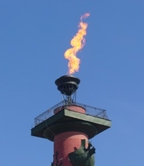 The Data Portal: Kronstadt fortress.This page is devoted to one of most interesting sites of Saint-Petersburg – Kronstadt city and fortress. During my guide practice I faced with very strange situation: 90% of foreign tourists who come to Saint-Petersburg know nothing about Kronstadt. At the same time they know about Peterhof, Tsarskoe Selo and Hermitage. Tsarskoe Selo with its famous Amber room is a commonly known brand of Saint-Petersburg and unsophisticated tourist never heard about Kronstadt. It is not surprisingly because people can’t find deep information about this city in Internet. I examined the most part of web-pages relevant to word “Kronstadt” and found that the most part of it devoted to Kronstadt rebellion. Of course this is a very important part of Kronstadt’s history but it is not at all. However I see that those tourists who visited this place were amazed Kronstadt’s rich history and monuments. Therefore I decided to create a web-page where you can find the information about history, monuments and present life of Kronstadt.
Structurally, this section will be consist of a number of articles and blocks where you can find interesting information and photos related to Kronstadt city and fortress.
History. Present-day situation.
Navy.
St.-Petersburg Dam. __________________________________________________________________________________ Before the mid-'90s, if you were a foreigner, you couldn't go to Kronstadt no matter how much you wanted to. Built as an island fortress and developed into a major naval base, Kronstadt was considered a site of military significance and was off-limits to foreigners. These days, the navy hasn't gone anywhere, but the authorities have obviously decided that there isn't much harm in letting tourists snap photos of warships all moored in a row. There are several reasons to go to Kronstadt. It has an interesting history, for a start. Peter the Great, who was an astute fellow, spotted that Kotlin Island, in the Gulf of Finland, would be a good place to create the military defenses for newly built St. Petersburg. The result was a complex series of fortifications, docks, canals and bays that were in many ways unique for their time. As Russia became more of a maritime power, Kronstadt grew in importance. It was from here that Russian sailors and explorers set off on the long voyages that would take them to the Arctic, North America, and all the way to Antarctica. It was also the base for many of Russia's greatest naval heroes. Aside from guarding the gateway to St. Petersburg and going about more warlike activities, Kronstadt also became a scientific and technological center. Since it's a naval town, a great many of the people on Kronstadt's streets are in uniform. There are also plenty of navy cadets about - rows of disciplined boys in neat uniforms. The town itself is not as neat and tidy as the sailors' uniforms. Although it is close to Petersburg, it has something of a neglected garrison town feel about it. |
 |
|
|
|
|


